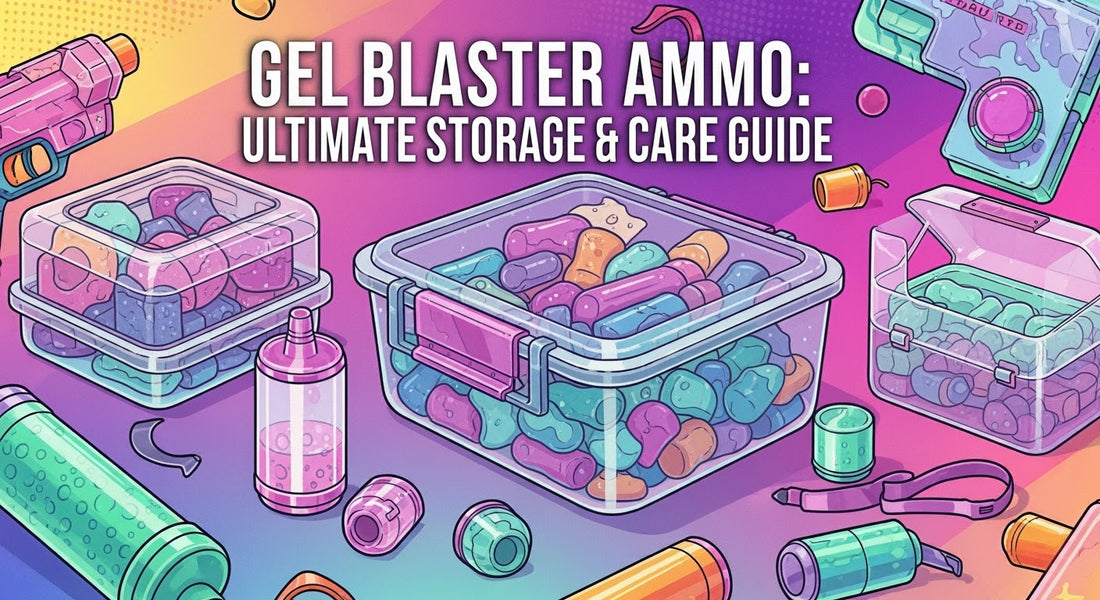
Are Gel Blaster Water Beads Safe for the Environment?
Share
Introduction
(I) The Environmental Question in Gel Blasting
Gel blasters have become a beloved pastime for enthusiasts of all ages, offering hours of safe, active fun. But as outdoor play grows in popularity, a critical question emerges: Are the water beads used in gel blasters safe for the environment? With increasing global focus on sustainability, players and parents alike are rightfully concerned about the impact of discarded beads on soil, waterways, and wildlife. A single outdoor battle can leave hundreds of spent beads scattered across lawns, parks, or wooded areas—raising fears of pollution, animal ingestion, and long-term ecological harm. The truth is, not all water beads are created equal when it comes to environmental safety, and understanding the difference is key to enjoying gel blasting responsibly.
(II) What This Guide Uncovers
In this in-depth blog, we’ll tackle the environmental safety of gel blaster water beads head-on. We’ll start by breaking down the composition of common gel beads, explaining why some are problematic and others are eco-friendly. Next, we’ll examine the real-world impacts of improper disposal—from clogged drainage systems to wildlife risks. We’ll also highlight biodegradable alternatives that let you play without harming the planet, plus practical tips for sustainable gel blasting. By the end, you’ll have all the facts you need to make informed choices and keep your gel blaster hobby green.
What Are Gel Blaster Water Beads Made Of?
(I) The Two Main Types: Synthetic vs. Biodegradable
The environmental impact of gel blaster water beads starts with their ingredients. Most beads fall into one of two categories:
-
Synthetic Water Beads: The most common type, made of sodium polyacrylate—a synthetic superabsorbent polymer (SAP) derived from petroleum. This material is highly absorbent, durable enough for gel blaster firing, and cheap to produce. However, synthetic SAP is not biodegradable; it breaks down into microplastics over hundreds of years, posing long-term environmental risks.
-
Biodegradable Water Beads: Made from plant-based polymers like alginate (from seaweed) or starch (from corn or potatoes). These beads mimic the performance of synthetic ones—expanding to the right size, withstanding firing, and reducing jams—but they break down naturally in the environment within weeks to months. They’re free of petroleum-based ingredients and do not leave behind microplastics.
(II) Key Differences in Environmental Impact
The biggest distinction between synthetic and biodegradable beads is their degradation rate and byproducts. Synthetic beads can persist in soil or water for decades, slowly fragmenting into microplastics that enter the food chain. Biodegradable beads, by contrast, are consumed by bacteria and fungi in the environment, breaking down into harmless substances like water, carbon dioxide, and organic matter. Additionally, synthetic beads may contain additives (like colorants or stabilizers) that can leach into soil or water, while reputable biodegradable brands use non-toxic, plant-based dyes.
The Environmental Risks of Synthetic Gel Beads
Improperly disposed synthetic gel beads pose several significant environmental threats:
(I) Microplastic Pollution
When synthetic beads are left outdoors, they don’t fully decompose—they break down into tiny microplastic particles (less than 5mm in size). These microplastics are easily carried by rainwater into streams, rivers, and oceans, where they’re ingested by fish, birds, and other wildlife. Once ingested, microplastics can cause internal damage, block digestive systems, and accumulate in the food chain—eventually reaching humans. A 2023 study by the Environmental Protection Agency (EPA) found that microplastics from SAP materials are now present in 60% of freshwater samples tested in urban areas.
(II) Wildlife Ingestion and Harm
Birds, small mammals, and even insects often mistake colorful synthetic beads for food (like berries or seeds) or water sources. When ingested, the beads can expand in an animal’s stomach, causing blockages that lead to starvation or death. Pet owners have also reported cases of dogs and cats becoming ill after eating spilled gel beads. Even if animals survive ingestion, the synthetic material can linger in their bodies, causing long-term health issues.
(III) Soil and Water Contamination
Synthetic beads can disrupt soil structure by absorbing moisture and creating waterlogged pockets, harming plant roots and reducing soil aeration. In waterways, they can clog drainage systems, filter beds, and aquatic plant roots, disrupting natural water flow and oxygen levels. The colorants and additives in some synthetic beads may also leach into soil or water over time, potentially toxic to plants and aquatic life.
(IV) Long-Term Persistence
Unlike organic matter that decomposes quickly, synthetic SAP beads can persist in the environment for 50-100 years or more. This means every spilled bead from a gel blaster battle adds to a growing accumulation of plastic waste that future generations will have to deal with. Even "disappeared" beads—those that sink into soil or wash away—are not gone; they’re just out of sight, slowly breaking down into microplastics.
Are Biodegradable Gel Beads the Solution?
(I) How Biodegradable Beads Work
Biodegradable gel beads are designed to mimic the performance of synthetic ones while being kind to the planet. Made from renewable, plant-based polymers, they expand to the standard 7-8mm size for gel blasters and have similar durability during firing. The key difference is their end-of-life: when exposed to soil, water, and microbes, the polymers break down through biohydrolysis (breakdown by water and enzymes) and biodegradation (consumption by microorganisms). Most biodegradable beads fully decompose within 2-8 weeks in outdoor conditions, leaving no trace behind.
(II) Testing and Certifications to Look For
Not all beads labeled "biodegradable" are created equal. To ensure you’re buying a truly eco-friendly product, look for these certifications:
-
ASTM D6400: A U.S. standard that certifies products are compostable in industrial composting facilities (some beads also meet home composting standards).
-
EN 13432: A European standard for compostability, ensuring beads break down into organic matter within 12 weeks.
-
OK Compost Home: A certification indicating beads can decompose in home compost bins, making them ideal for backyard disposal.
Avoid beads labeled "biodegradable" without third-party certification—these may only break down partially or require extreme conditions (like high heat) to decompose.
(III) Performance Comparison to Synthetic Beads
Many players worry that biodegradable beads won’t perform as well as synthetic ones, but modern formulations have closed the gap. Biodegradable beads offer:
-
Similar Durability: They withstand firing without breaking mid-flight, reducing jams in gel blasters.
-
Uniform Size: High-quality biodegradable beads have consistent sizing, ensuring accurate shots.
-
Non-Toxic: No petroleum-based additives, making them safer for players and the environment.
The only minor downside is cost: biodegradable beads are typically 20-30% more expensive than synthetic ones. But the environmental benefit is well worth the small premium for eco-conscious players.
Sustainable Practices for Gel Blaster Water Beads
Even with biodegradable beads, responsible use and disposal are key to minimizing environmental impact. Follow these sustainable practices:
(I) Choose Biodegradable Beads Whenever Possible
Make biodegradable beads your go-to ammo, especially for outdoor play. Look for trusted brands like EcoGel, Bioblaster, or GreenBead that have the certifications mentioned above. For indoor play, synthetic beads are less of a risk (since they can be easily cleaned up), but biodegradable options are still better for overall sustainability.
(II) Clean Up All Spilled Beads
Never leave beads scattered after a gel blaster session—even biodegradable ones. Bring a broom, dustpan, and reusable bag to collect spent or spilled beads. For outdoor battles, do a "sweep search" to pick up stray beads, especially in grassy or wooded areas where they’re hard to see. This prevents wildlife ingestion and keeps public spaces clean.
(III) Dispose of Beads Properly
-
Biodegradable Beads: Compost them in a home compost bin, bury them in your garden, or throw them in the green waste bin (if your community accepts compostable materials). They’ll break down quickly and enrich the soil.
-
Synthetic Beads: Collect them in a sealed plastic bag and throw them in the regular trash. Never flush them down the toilet or sink (they’ll clog pipes) or bury them in the garden (they’ll persist for decades).
(IV) Avoid Over-Preparing Beads
Only hydrate the number of beads you need for a play session. Over-preparing leads to unused beads that may go to waste. If you have leftover hydrated beads, store them in a sealed container (as outlined in our earlier guide) and use them within 2-3 days. Dried leftover beads can be rehydrated later.
(V) Play in Designated Areas
Stick to designated gel blaster fields or private property for battles. These areas are easier to clean up and less likely to have sensitive ecosystems (like wetlands or wildlife habitats). Avoid playing in parks, forests, or near waterways unless you have permission and can guarantee full cleanup.
Debunking Common Myths About Water Beads and the Environment
Let’s set the record straight on some widespread misconceptions:
-
Myth: All water beads are biodegradable. Fact: Most cheap, generic beads are synthetic and non-biodegradable. Always check for certification.
-
Myth: Synthetic beads are harmless because they’re "just plastic." Fact: Synthetic SAP beads break down into microplastics, which are a major environmental threat to wildlife and ecosystems.
-
Myth: Biodegradable beads break down immediately, so cleanup isn’t necessary. Fact: Even biodegradable beads take weeks to decompose and can be ingested by animals in the meantime. Cleanup is still required.
-
Myth: Gel blaster beads are too small to affect the environment. Fact: Small size makes them more likely to be ingested by small animals and carried into waterways, amplifying their impact.
The Future of Eco-Friendly Gel Blasting
As environmental awareness grows, the gel blaster industry is shifting toward sustainability. More manufacturers are developing plant-based, compostable beads, and some are even exploring edible beads (made from food-grade ingredients) for maximum safety. Additionally, gel blaster fields are adopting "zero-waste" policies, requiring players to use biodegradable ammo and participate in cleanup. This trend not only protects the environment but also makes gel blasting more accessible to communities concerned about pollution.
Conclusion
(I) The Bottom Line on Environmental Safety
Gel blaster water beads can be safe for the environment—if you choose the right type and use them responsibly. Synthetic beads pose significant risks, including microplastic pollution and wildlife harm, while certified biodegradable beads break down harmlessly. The key steps to eco-friendly gel blasting are: opt for biodegradable ammo, clean up all spills, dispose of beads properly, and play in designated areas.
(II) Play Green, Play Responsibly
There’s no need to sacrifice fun for sustainability. By making small changes to your gel blaster routine—like switching to biodegradable beads and committing to cleanup—you can enjoy your hobby while protecting the planet. Share these tips with your fellow players and encourage your local gel blaster community to go green. Together, we can ensure that gel blasting remains a fun, safe activity for years to come—for both players and the environment.
